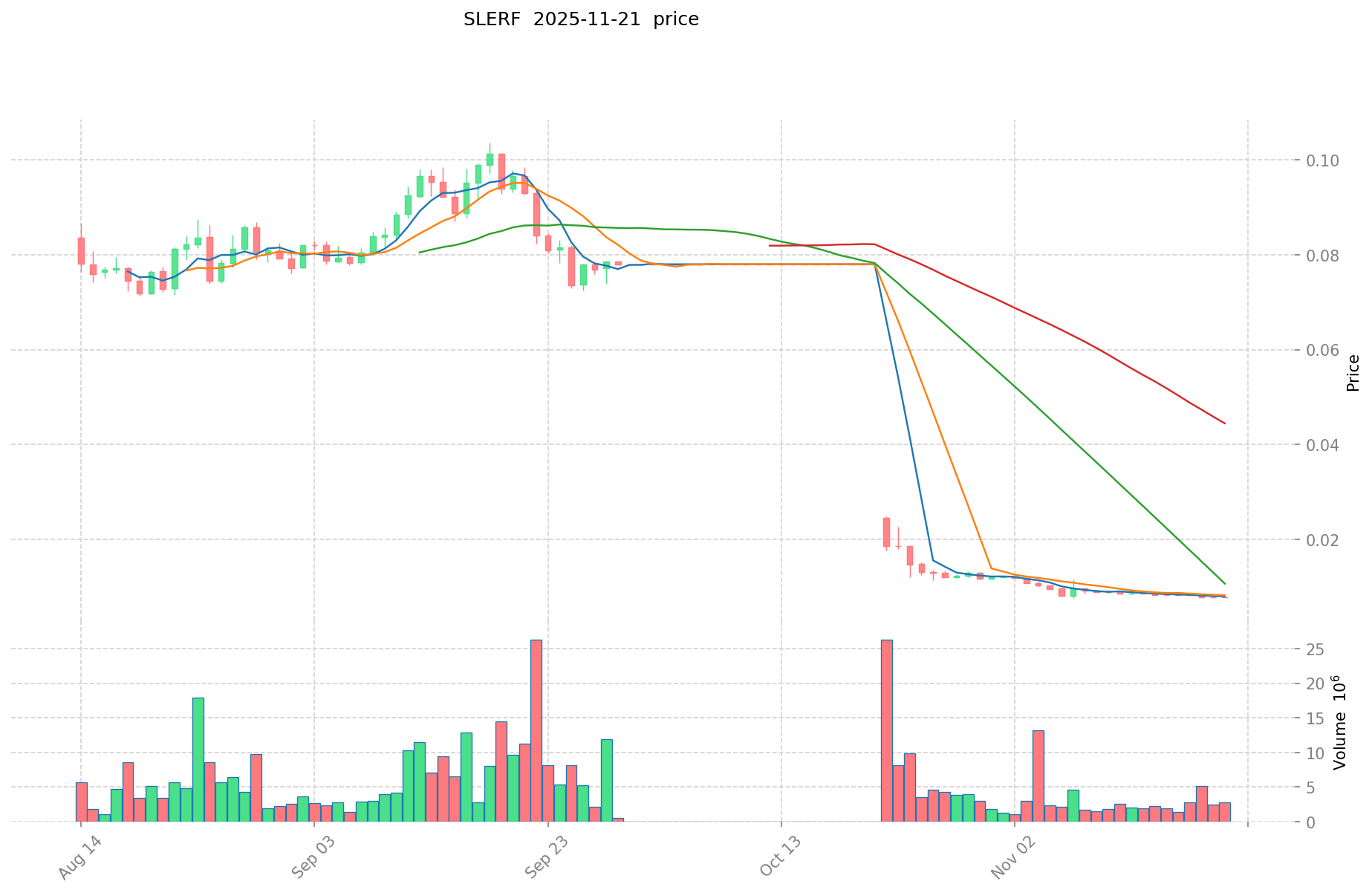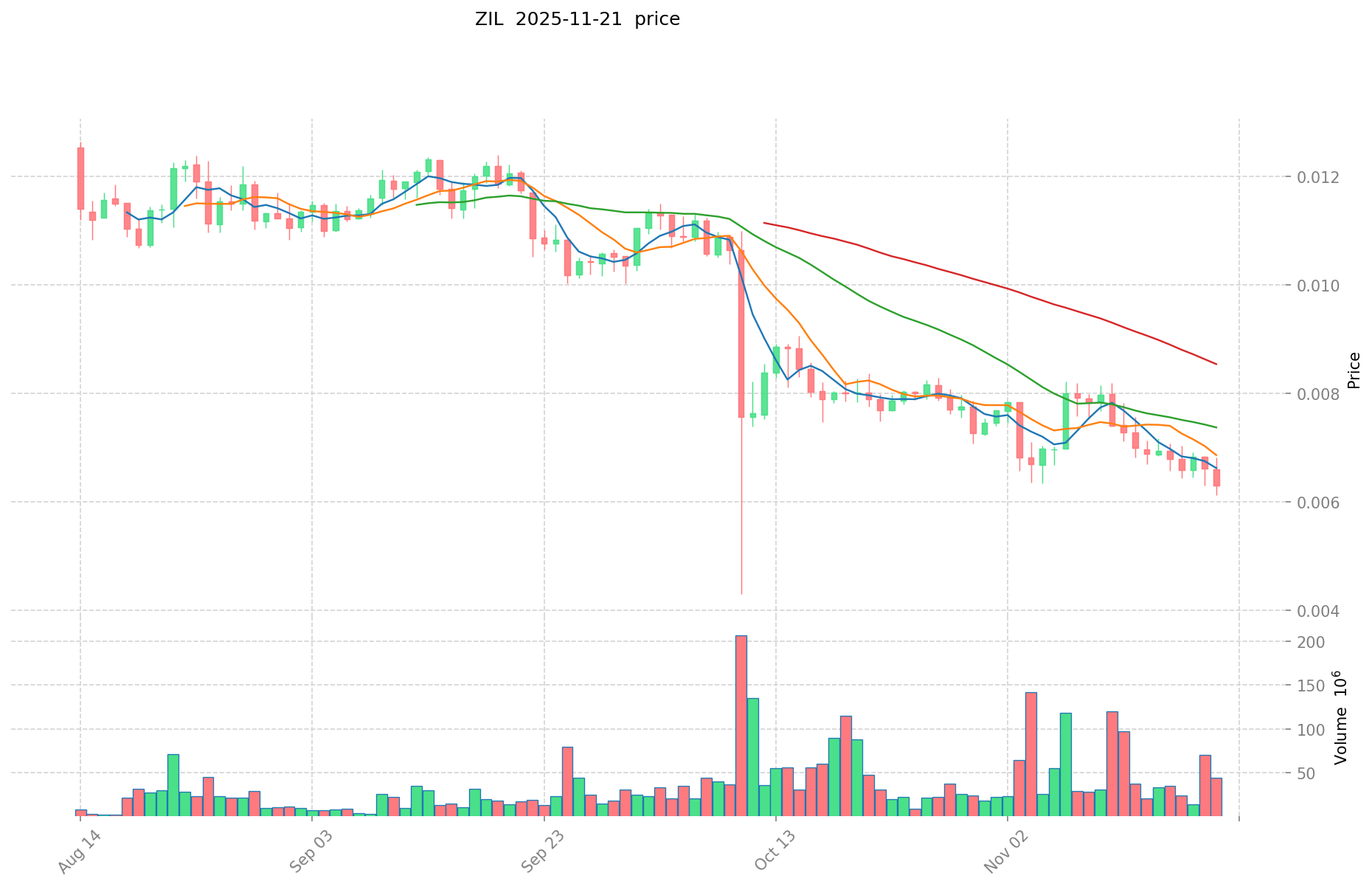SLERF vs ZIL: A Comparative Analysis of Emerging Blockchain Technologies for Smart Contracts
Introduction: SLERF vs ZIL Investment Comparison
In the cryptocurrency market, SLERF vs ZIL comparison has been an unavoidable topic for investors. The two not only show significant differences in market cap ranking, application scenarios, and price performance, but also represent different crypto asset positioning.
Slerf (SLERF): Launched as a meme coin on the Solana blockchain, featuring a character modeled after the animal sloth.
Zilliqa (ZIL): Since its launch in 2018, it has gained market recognition for its high-throughput public blockchain platform, aiming to solve transaction speed and scalability issues.
This article will comprehensively analyze the investment value comparison between SLERF and ZIL, focusing on historical price trends, supply mechanisms, institutional adoption, technical ecosystems, and future predictions, attempting to answer the question investors care about most:
"Which is the better buy right now?"
I. Price History Comparison and Current Market Status
SLERF and ZIL Historical Price Trends
- 2024: SLERF reached its all-time high of $1.4877 on March 19, 2024.
- 2021: ZIL hit its all-time high of $0.255376 on May 7, 2021.
- Comparative analysis: SLERF has experienced a significant drop from its all-time high, falling to $0.007657 as of November 22, 2025. Similarly, ZIL has declined from its peak, currently trading at $0.005802.
Current Market Situation (2025-11-22)
- SLERF current price: $0.007657
- ZIL current price: $0.005802
- 24-hour trading volume: SLERF $13,535.10 vs ZIL $516,767.21
- Market Sentiment Index (Fear & Greed Index): 14 (Extreme Fear)
Click to view real-time prices:
- Check SLERF current price Market Price
- Check ZIL current price Market Price


II. Core Factors Affecting SLERF vs ZIL Investment Value
Supply Mechanism Comparison (Tokenomics)
- SLERF: Limited supply with a maximum cap of 900 million tokens. 37% of tokens allocated to the community, 30% to the Slerf team, and 33% to airdrops/early supporters.
- ZIL: Fixed maximum supply of 21 billion tokens. Employs a more traditional tokenomics model with gradual release.
- 📌 Historical pattern: Fixed supply models like SLERF's tend to create scarcity-driven price dynamics, while ZIL's larger supply cap may lead to more gradual appreciation.
Institutional Adoption and Market Applications
- Institutional holdings: ZIL has greater institutional presence due to its longer market history and established partnerships.
- Enterprise adoption: ZIL has more practical applications in payment systems and enterprise solutions through partnerships like the one with Nestlé.
- Regulatory stance: Both tokens face varying regulatory approaches, with ZIL's longer market presence providing more regulatory clarity compared to SLERF.
Technical Development and Ecosystem Building
- SLERF technical focus: Specializes in high-quality visual content generation with seamless integration of image effects.
- ZIL technical development: Focuses on scalable blockchain infrastructure with sharding technology and the Scilla programming language for secure smart contracts.
- Ecosystem comparison: ZIL has a more developed ecosystem spanning DeFi, NFTs, and enterprise solutions, while SLERF remains focused on its core visual generation technology.
Macroeconomic and Market Cycles
- Performance in inflationary environments: ZIL's established history provides more data points for inflation resistance analysis.
- Macroeconomic monetary policy: Interest rates and USD index fluctuations typically affect newer assets like SLERF more dramatically than established tokens like ZIL.
- Geopolitical factors: ZIL's wider global adoption and partnerships provide potentially greater resilience to regional regulatory changes.
III. 2025-2030 Price Prediction: SLERF vs ZIL
Short-term Prediction (2025)
- SLERF: Conservative $0.00635531 - $0.007657 | Optimistic $0.007657 - $0.00941811
- ZIL: Conservative $0.0043455 - $0.005794 | Optimistic $0.005794 - $0.00787984
Mid-term Prediction (2027)
- SLERF may enter a growth phase, with prices expected in the range of $0.007816985358 - $0.0118185373865
- ZIL may enter a growth phase, with prices expected in the range of $0.006079389264 - $0.0099989955
- Key drivers: Institutional capital inflow, ETFs, ecosystem development
Long-term Prediction (2030)
- SLERF: Base scenario $0.014191156459756 - $0.019441884349866 | Optimistic scenario $0.019441884349866+
- ZIL: Base scenario $0.012900204044325 - $0.013932220367871 | Optimistic scenario $0.013932220367871+
Disclaimer: This analysis is based on historical data and current market trends. Cryptocurrency markets are highly volatile and unpredictable. This information should not be considered as financial advice. Always conduct your own research before making investment decisions.
SLERF:
| 年份 | 预测最高价 | 预测平均价格 | 预测最低价 | 涨跌幅 |
|---|---|---|---|---|
| 2025 | 0.00941811 | 0.007657 | 0.00635531 | 0 |
| 2026 | 0.0100743149 | 0.008537555 | 0.00640316625 | 11 |
| 2027 | 0.0118185373865 | 0.00930593495 | 0.007816985358 | 21 |
| 2028 | 0.012991550486947 | 0.01056223616825 | 0.008344166572917 | 37 |
| 2029 | 0.016605419591914 | 0.011776893327598 | 0.01142358652777 | 53 |
| 2030 | 0.019441884349866 | 0.014191156459756 | 0.009508074828036 | 85 |
ZIL:
| 年份 | 预测最高价 | 预测平均价格 | 预测最低价 | 涨跌幅 |
|---|---|---|---|---|
| 2025 | 0.00787984 | 0.005794 | 0.0043455 | 0 |
| 2026 | 0.0091614728 | 0.00683692 | 0.0038970444 | 17 |
| 2027 | 0.0099989955 | 0.0079991964 | 0.006079389264 | 37 |
| 2028 | 0.0121487795325 | 0.00899909595 | 0.0053094666105 | 55 |
| 2029 | 0.0152264703474 | 0.01057393774125 | 0.009516543967125 | 82 |
| 2030 | 0.013932220367871 | 0.012900204044325 | 0.008901140790584 | 122 |
IV. Investment Strategy Comparison: SLERF vs ZIL
Long-term vs Short-term Investment Strategies
- SLERF: Suitable for investors focused on emerging meme coins and visual content generation potential
- ZIL: Suitable for investors looking for established blockchain infrastructure and enterprise adoption
Risk Management and Asset Allocation
- Conservative investors: SLERF: 20% vs ZIL: 80%
- Aggressive investors: SLERF: 60% vs ZIL: 40%
- Hedging tools: Stablecoin allocation, options, cross-currency portfolios
V. Potential Risk Comparison
Market Risks
- SLERF: High volatility due to meme coin status and newer market presence
- ZIL: Susceptible to overall crypto market trends and competition from other blockchain platforms
Technical Risks
- SLERF: Scalability, network stability
- ZIL: Hash power concentration, security vulnerabilities
Regulatory Risks
- Global regulatory policies may impact both differently, with ZIL potentially facing more scrutiny due to its wider adoption
VI. Conclusion: Which Is the Better Buy?
📌 Investment Value Summary:
- SLERF advantages: Limited supply, potential for rapid growth, focus on visual content generation
- ZIL advantages: Established history, enterprise partnerships, developed ecosystem
✅ Investment Advice:
- New investors: Consider a small allocation to SLERF for high-risk, high-reward potential, with a larger portion in ZIL for stability
- Experienced investors: Balanced approach with both tokens, adjusting based on risk tolerance and market trends
- Institutional investors: Focus on ZIL for its established partnerships and infrastructure, with potential small allocation to SLERF for diversification
⚠️ Risk Warning: The cryptocurrency market is highly volatile. This article does not constitute investment advice. None
VII. FAQ
Q1: What are the main differences between SLERF and ZIL? A: SLERF is a meme coin on the Solana blockchain focused on visual content generation, while ZIL is an established blockchain platform aiming to solve scalability issues. SLERF has a limited supply of 900 million tokens, whereas ZIL has a larger supply cap of 21 billion tokens. ZIL has a more developed ecosystem and enterprise partnerships, while SLERF is newer with potential for rapid growth.
Q2: Which coin has shown better price performance historically? A: Both coins have experienced significant drops from their all-time highs. SLERF reached its peak of $1.4877 in March 2024 and is currently trading at $0.007657. ZIL hit its all-time high of $0.255376 in May 2021 and is now trading at $0.005802. While SLERF's peak was more recent, both have seen substantial declines.
Q3: How do the supply mechanisms of SLERF and ZIL differ? A: SLERF has a limited supply with a maximum cap of 900 million tokens, with 37% allocated to the community, 30% to the team, and 33% to airdrops/early supporters. ZIL has a fixed maximum supply of 21 billion tokens with a more traditional tokenomics model and gradual release. SLERF's model may create more scarcity-driven price dynamics.
Q4: Which coin has better institutional adoption? A: ZIL has greater institutional presence due to its longer market history and established partnerships, such as its collaboration with Nestlé. It also has more practical applications in payment systems and enterprise solutions. SLERF, being newer, has less institutional adoption at this time.
Q5: What are the long-term price predictions for SLERF and ZIL? A: For 2030, SLERF's base scenario price range is predicted to be $0.014191156459756 - $0.019441884349866, with an optimistic scenario above $0.019441884349866. ZIL's base scenario for 2030 is $0.012900204044325 - $0.013932220367871, with an optimistic scenario above $0.013932220367871. However, these predictions are speculative and subject to market volatility.
Q6: How should investors allocate their portfolio between SLERF and ZIL? A: For conservative investors, a suggested allocation is 20% SLERF and 80% ZIL. For aggressive investors, the recommendation is 60% SLERF and 40% ZIL. New investors might consider a small allocation to SLERF for high-risk, high-reward potential, with a larger portion in ZIL for stability. Experienced investors could take a balanced approach, adjusting based on risk tolerance and market trends.
Q7: What are the main risks associated with investing in SLERF and ZIL? A: SLERF faces high volatility due to its meme coin status and newer market presence, as well as potential scalability and network stability issues. ZIL is susceptible to overall crypto market trends, competition from other blockchain platforms, and risks related to hash power concentration and security vulnerabilities. Both coins are subject to regulatory risks, with ZIL potentially facing more scrutiny due to its wider adoption.
Share
Content